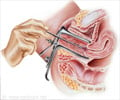Anatomy of Uterus & Female Reproductive System
The female reproductive organs are made up of the vulva, the vagina, the uterus, the fallopian tubes, and the ovaries.
The uterus is a hollow, muscular, pear-shaped organ that becomes home to a developing fetus. The uterus is divided into two parts: the lower part of the uterus that opens into the vagina is called the cervix; the main body of the uterus, is called the corpus. The uterus has three layers.
The endometrium is the innermost layer of the uterus. The thickness of the endometrium is regulated by hormones and so varies according to the phase of the menstrual cycle. Another name for this lining is the mucosa.
Hormonal changes during a woman’s menstrual cycle cause the endometrium to change and every month during a menstrual period a part of it sheds out.
Myometrium is a thick wall in the middle layer of the uterus containing smooth muscle cells
Serosa is a membrane covering the outermost layer of the uterus. It is so thin that it blends with the connective tissue (ligaments), which suspends the uterus in the pelvis.

The blood supply to the uterus is through the uterine arteries, which are branches of the aorta, which is the main blood vessel of the body.
The vagina is a canal that joins the cervix to the outside of the body. It also is known as the birth canal.
The ovaries are small, oval-shaped glands about the size of an almond that are located on either side of the uterus. The ovaries produce eggs and hormones.
The upper part of the uterus is connected to the fallopian tubes where the all- important function of conception takes place. It is in the fallopian tubes that the egg is fertilized by the sperm after which the fertilized egg moves to the uterus, where it implants to grow into an embryo.
The blood supply to the uterus is through the uterine arteries, which are branches of the aorta, which is the main blood vessel of the body.
The vagina is a canal that joins the cervix to the outside of the body. It also is known as the birth canal.
The ovaries are small, oval-shaped glands about the size of an almond that are located on either side of the uterus. The ovaries produce eggs and hormones.
The upper part of the uterus is connected to the fallopian tubes where the all- important function of conception takes place. It is in the fallopian tubes that the egg is fertilized by the sperm after which the fertilized egg moves to the uterus, where it implants to grow into an embryo.








